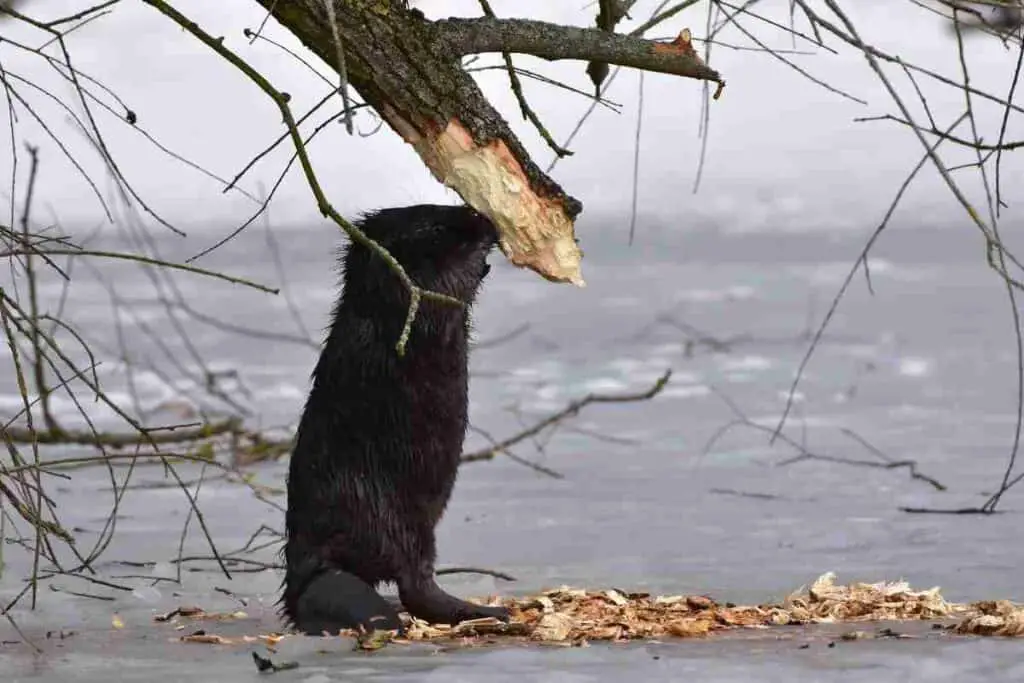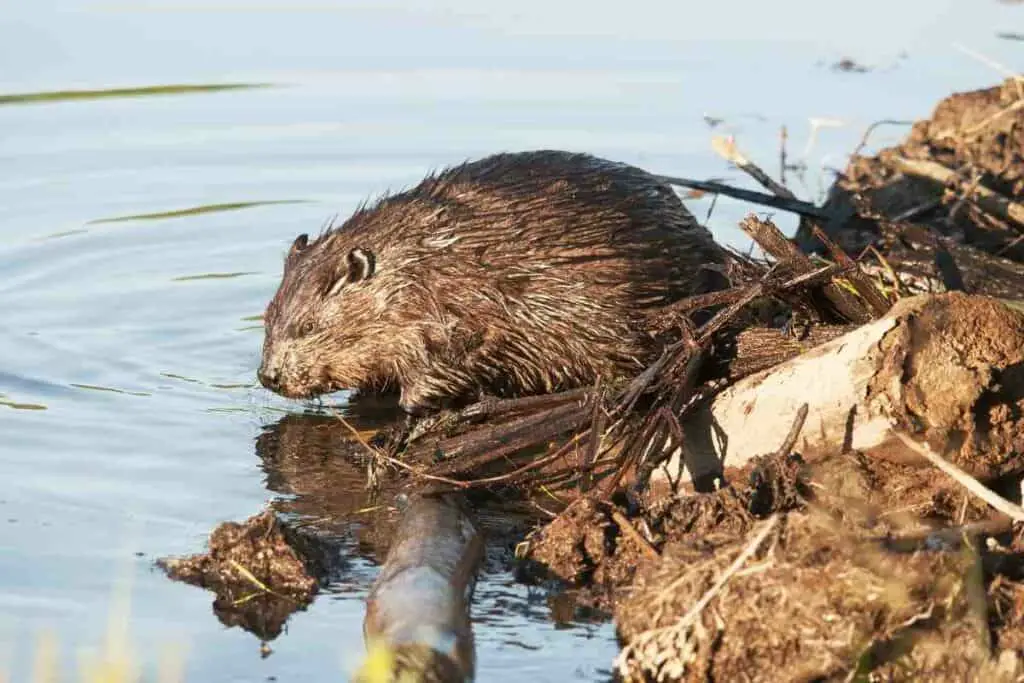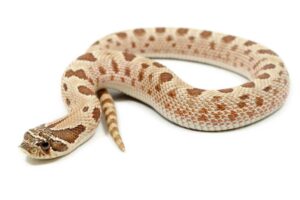Beavers are herbivorous semi-aquatic animals. They are well-known for their dam-building habit.
These dams protect them from predators, but the effects of dam construction and tree destruction can occasionally bring them into conflict with people.
Beavers have thick hair, webbed feet, and scale-covered flattened tails. They are well known for using their enormous jaws and teeth to break trees to create homes and dams.
Beavers cannot climb trees and can only chew around the tree trunks to get the branches for building materials for their lodges. This is because their body has not been genetically adapted to climb trees.
They also don’t get in backyards unless the property is near a pond, river, lake or streams or if the area is full of trees.

Table of Contents
Why Are Beavers Not Good Tree Climbers?
Weight
Beavers tend to be pretty heavy as they continue to grow throughout their lifetimes, with males and females reaching the same weight and length. They may weigh up to 70 pounds but have been reported to weigh up to 100 pounds.
Their whole-body weight makes it difficult for them to climb a tree with ease as it requires so much work and strain to drag themselves up a tree.
Furthermore, it would be impossible for them to maintain their equilibrium because of their bottom-heavy nature.
However, with exponential willpower, beavers might be able to make it up to four feet before giving up. Their adorable tiny butts provide a challenge while climbing straight up and down.
Webbed Feet
Another reason why beavers are bad tree climbers is that their feet do not satisfy critical conditions for climbing a tree trunk. They lack opposable thumbs and retractable claws, required as their feet are webbed.
This makes it challenging for them to grab the tree’s branches and pull themselves up. Furthermore, their tiny legs make it difficult for them to scramble up a tree quickly.
Poor Eyesight
Beavers have small black eyes. They are close-sighted creatures and mainly rely on their sense of smell when navigating.
Since their eyesight isn’t sharp and they can’t see correctly during the day or at night, it would be difficult to know where to grip.
Do Beavers Get in Backyards?
Beavers are not commonly found in people’s yards; in fact, they strive to avoid people because they regard them as predators.
However, some can get in your property if it is near a freshwater beaver pond, rivers, marshes, swamps, or if your yard has trees (trees they like include aspen, cottonwood, apple, birch, and cherry).
Because beavers are nocturnal, you are unlikely to see them during the day. However, here are several clues that they may be settling on your property:
Droppings: Beaver scat is shaped like a pellet, either round or elongated and is 3/4 to 1 inch in diameter. Their waste is light brown to tan in color and is packed with microscopic particles of woody fiber. The pellets are little balls of sawdust that rapidly dissolve when disturbed.
Sounds: Adult beavers don’t make much noise; however, the young can generate noises similar to a duck quacking. They also whine and create a variety of other sounds.

Chewing on trees: Beavers are sometimes called the “engineers of the woods” and they indeed are. They can fell trees of various sizes. They frequently gnaw around the tree’s trunk but leave the tree standing and let the wind do the rest.
The reason why beavers destroy trees is to access the thinner branches near the top. They eat the leaves, shoots, and bark. They then utilize the bigger branches to create lodges and dams.
Footprints: Every animal that wanders the world leaves a distinct imprint. Beaver footprints, however, are frequently difficult to notice due to their large tails, which they drag behind them on the ground, distorting the impressions, or by pulling the branches, which has a similar effect.
Beaver’s feet are pretty straightforward to identify, especially near a body of water on your property. The rear feet are more significant than the front paws, and webbing is only present between the toes of the back feet.
Both the front and hind paws have five fingers.
How To Get Rid of Beavers in Your Property?
Beavers are extremely tough to control due to their versatility and perseverance. Beavers may be exceedingly damaging in particular areas, necessitating careful beaver management.
Use A Live Trap
A live trap is the most effective approach to eliminate beavers from your property. Trapping a beaver necessitates the proper trap, precise location, and patience. Because beavers have established migratory habits, trap positioning is critical.
Set your trap in the twilight and place it near a beaver slide or dam crossing. After you’ve placed the trap, you’ll want to fill it with bait. Beaver Castor, poplar branches and tree limbs, twigs and branches soaked in poplar oil, or apples are all excellent beaver attractors.
A combination of all of these baits will increase your chances of success. Once captured, either surrender the Beaver to animal control or drive it into the wild and release it.
Use Animal Repellant
Nature’s Defense is an organic, all-natural repellant that is effective against a wide range of animals. Sprinkle it along the perimeter of your yard near trees and in areas where beavers often congregate.
Use it twice a week for the first two weeks, then once a week for maintenance. Your beaver problem will be treated fast and effortlessly.
Fence Trees
Beavers rely on trees for food and construction materials. Individual trees can be protected against beaver nibbling by wrapping wire cylinders around their trunks.
The hefty wire cylinder’s sole purpose is to prevent the beaver from reaching the tree. This makes the environment less appealing for them; hence they move on to another region.
Create A Perimeter Around Your Yard
Another most effective measure to get rid of beavers is to build a perimeter around your property using a wire fence or electric fencing. If done correctly, it has the potential to exclude beavers completely.
The fence does not need to be tall because beavers cannot climb; thus, a 3 to 4 ft high fence should suffice.
Dismantle Their Habitat
Beavers can also be deterred by destroying their dams and lodges. Sometimes the technique works the first time perfectly.
However, beavers can be persistent and capable of repairing their dam overnight. Therefore, you must continue to dismantle their lodges.
They will eventually realize how pointless it is to construct dams in your region and finally migrate away.
Final Thoughts
Beavers are not good at climbing trees. They want to stick to the water where their weight isn’t an issue and their webbed feet work in their favor.
Beavers may be exceedingly destructive with their well-developed incisor teeth and powerful lower jaw muscles; they can collapse big trees to collect food and building materials thus necessitating careful beaver management.










